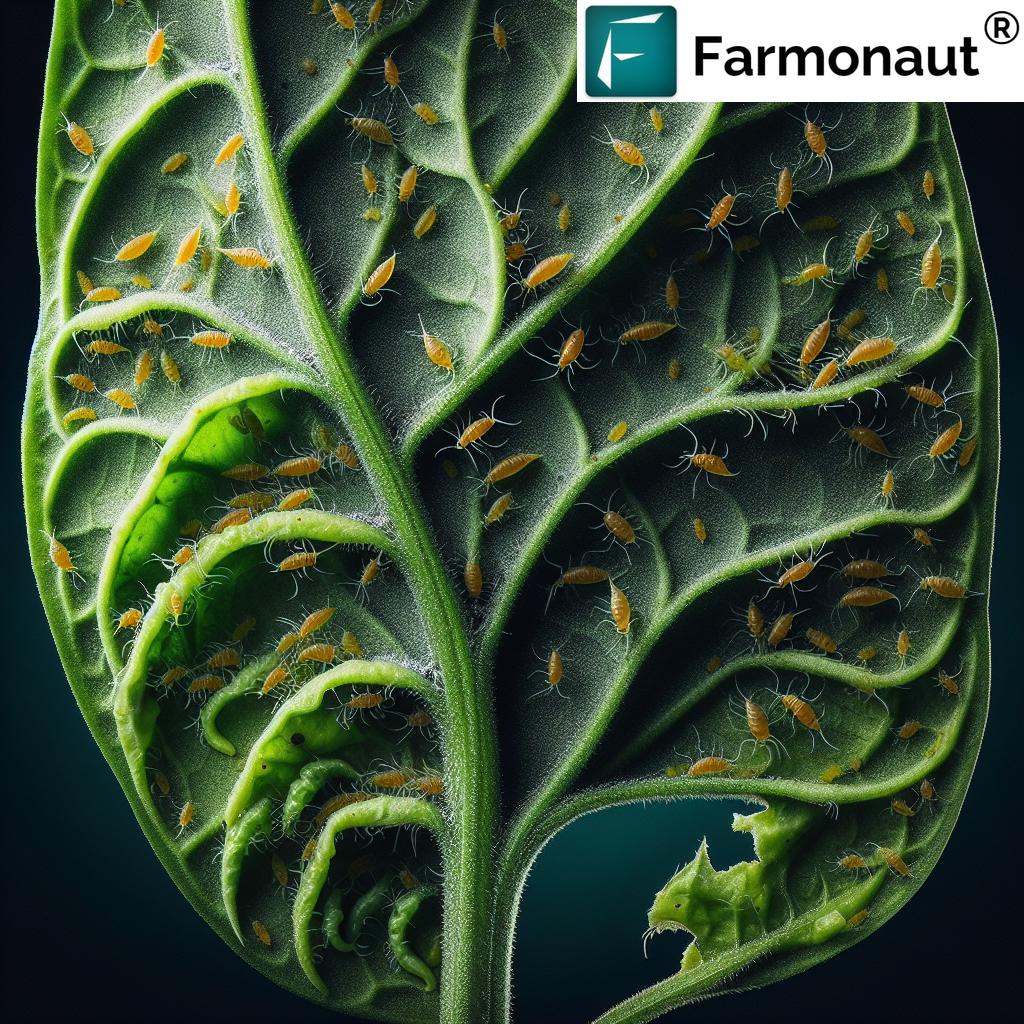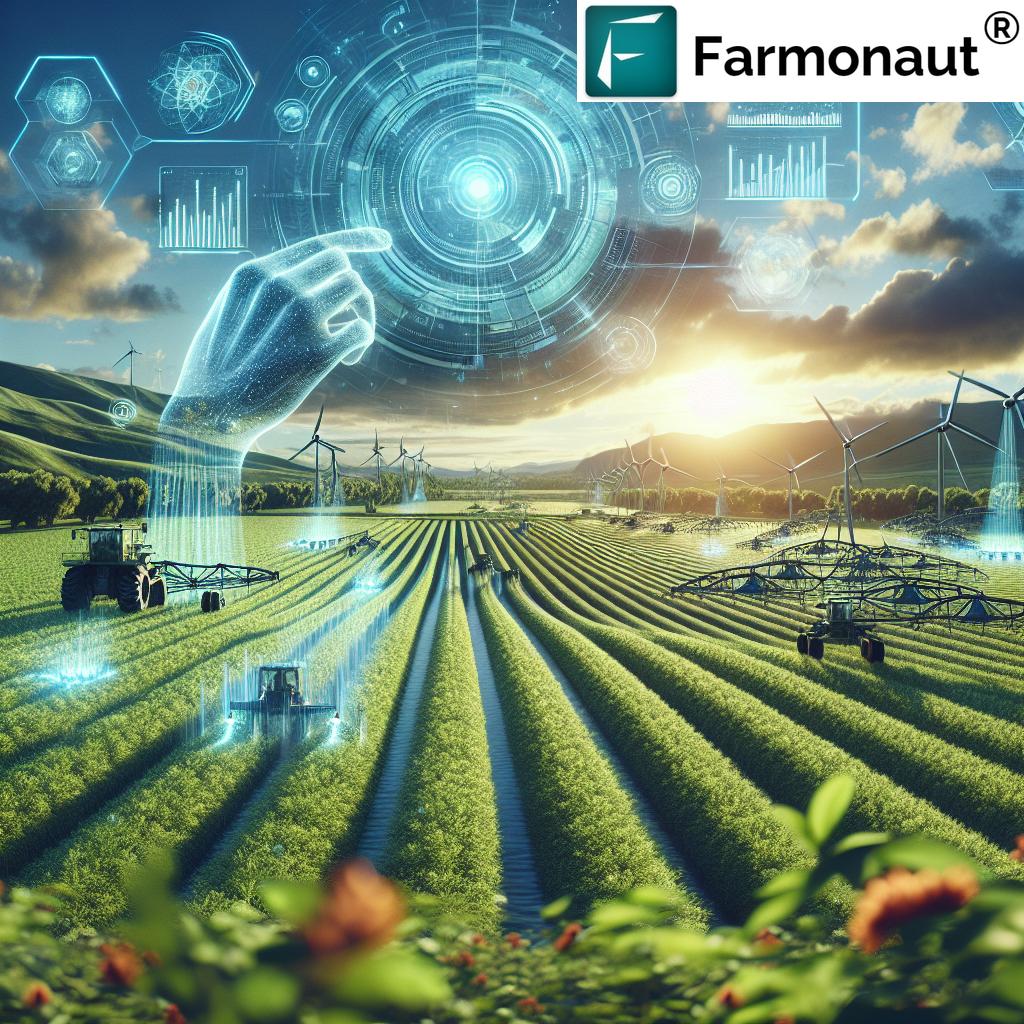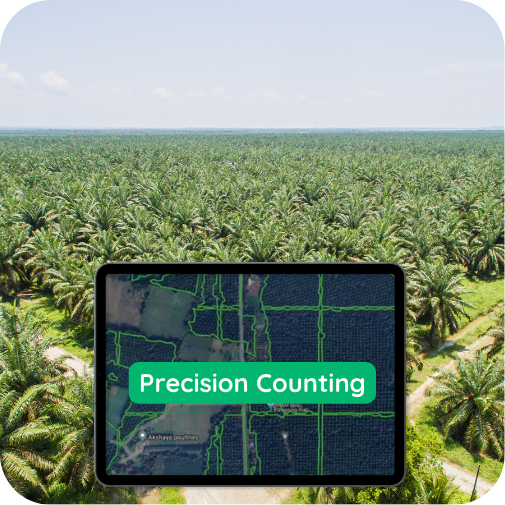Exploring Soil Organic Carbon’s Role with Farmonaut: Unveiling the Key to Sustainable Agriculture

Welcome to Farmonaut®! In this comprehensive blog post, we delve deep into the crucial role of Soil Organic Carbon (SOC) in boosting soil health, fertility, and agricultural productivity. As pioneers in agricultural technology, we at Farmonaut understand the paramount importance of SOC in creating thriving fields and enhancing farm productivity. Join us as we explore the intricate relationship between SOC and sustainable agriculture, and discover how our advanced satellite technology and AI-driven solutions can help you monitor and optimize SOC levels for better yields and a healthier planet.
Table of Contents
- Understanding Soil Organic Carbon
- The Importance of Soil Organic Carbon
- Benefits of Organic Matter in Soil
- The Role of Organic Carbon in Soil
- Farmonaut’s Cutting-Edge Technology
- Monitoring SOC with Farmonaut
- Implementing Sustainable Practices
- The Future of Agriculture: SOC and Climate-Smart Farming
- Frequently Asked Questions
1. Understanding Soil Organic Carbon
Soil Organic Carbon (SOC) is a vital component of soil organic matter, which consists of plant and animal residues at various stages of decomposition. It plays a crucial role in soil fertility, structure, and overall health. SOC is the carbon stored in soil organic matter, and it’s essential for maintaining soil quality and supporting plant growth.
The Carbon Cycle and SOC
SOC is an integral part of the global carbon cycle. Plants absorb carbon dioxide from the atmosphere through photosynthesis and convert it into organic compounds. When plants die or shed leaves and roots, this organic matter is decomposed by soil microorganisms, releasing some carbon back into the atmosphere as CO2 while storing the rest in the soil as SOC.
The amount of SOC in soil depends on various factors, including:
- Climate conditions
- Soil type and texture
- Vegetation cover
- Land management practices
- Topography
Understanding these factors is crucial for maintaining and increasing SOC levels in agricultural soils, which is where Farmonaut’s advanced monitoring systems come into play.
2. The Importance of Soil Organic Carbon
The importance of organic carbon in soil cannot be overstated. It is the foundation of soil health and plays a critical role in sustainable agriculture. Here’s why SOC is so crucial:
Soil Structure and Water Retention
SOC improves soil structure by binding soil particles together, creating aggregates that enhance soil porosity. This improved structure leads to better water infiltration and retention, reducing runoff and erosion. Soils rich in organic carbon can hold up to 20 times their weight in water, making them more resilient to droughts and floods.
Nutrient Availability and Cycling
Organic carbon acts as a nutrient reservoir in the soil. As organic matter decomposes, it releases essential nutrients like nitrogen, phosphorus, and sulfur, making them available to plants. This natural nutrient cycling reduces the need for synthetic fertilizers, leading to more sustainable and cost-effective farming practices.
Microbial Activity and Biodiversity
SOC provides food and habitat for soil microorganisms, including bacteria, fungi, and earthworms. These organisms are crucial for maintaining soil health, as they break down organic matter, cycle nutrients, and create symbiotic relationships with plant roots. A thriving soil ecosystem leads to healthier crops and more resilient agricultural systems.
Carbon Sequestration and Climate Change Mitigation
One of the most significant roles of SOC is its potential for carbon sequestration. By storing carbon in the soil, we can reduce atmospheric CO2 levels, mitigating climate change. Agricultural practices that increase SOC not only improve soil health but also contribute to global efforts to combat climate change.
3. Benefits of Organic Matter in Soil
The benefits of organic matter in soil are numerous and far-reaching. Let’s explore some of the key advantages:
Enhanced Soil Fertility
Organic matter is a primary source of nutrients for plants. As it decomposes, it releases essential elements like nitrogen, phosphorus, and potassium, reducing the need for synthetic fertilizers. This natural nutrient release is often better synchronized with plant needs, leading to more efficient nutrient uptake.
Improved Soil Structure
Organic matter acts as a binding agent for soil particles, creating stable aggregates. This improved structure enhances:
- Soil aeration
- Root penetration
- Water infiltration and retention
- Resistance to erosion
Increased Water Holding Capacity
Soils rich in organic matter can retain more water, making them more resilient to drought conditions. This increased water holding capacity can lead to reduced irrigation needs and better crop performance during dry spells.
Enhanced Cation Exchange Capacity (CEC)
Organic matter increases the soil’s CEC, which is its ability to hold and exchange nutrients. A higher CEC means the soil can retain more nutrients, preventing leaching and making them available to plants over time.
Buffering Against pH Changes
Organic matter helps stabilize soil pH, buffering against rapid changes that could stress plants. This pH stability creates a more favorable environment for nutrient availability and microbial activity.
Promotion of Beneficial Microorganisms
Organic matter serves as a food source and habitat for beneficial soil microorganisms. These microbes play crucial roles in nutrient cycling, disease suppression, and the formation of symbiotic relationships with plant roots.
4. The Role of Organic Carbon in Soil
The role of organic carbon in soil is multifaceted and essential for maintaining a healthy and productive agricultural ecosystem. Let’s delve deeper into its specific functions:
Energy Source for Soil Microorganisms
Organic carbon serves as the primary energy source for soil microorganisms. These microbes, including bacteria, fungi, and protozoa, are responsible for numerous soil processes, including:
- Decomposition of organic matter
- Nutrient cycling
- Formation of soil aggregates
- Symbiotic relationships with plants
Soil Structure Improvement
Organic carbon plays a crucial role in forming and stabilizing soil aggregates. These aggregates improve soil structure by:
- Increasing pore space for better air and water movement
- Enhancing root penetration
- Reducing soil compaction
- Increasing resistance to erosion
Nutrient Storage and Release
Organic carbon acts as a slow-release nutrient bank in the soil. As organic matter decomposes, it gradually releases essential nutrients, providing a steady supply to plants throughout the growing season. This process reduces nutrient leaching and the need for frequent fertilizer applications.
Water Retention and Availability
Soils rich in organic carbon can hold significantly more water than those with low organic content. This increased water holding capacity:
- Reduces irrigation needs
- Improves drought resistance
- Enhances nutrient uptake by plants
- Reduces runoff and erosion
Pollutant Filtration and Degradation
Organic carbon in soil can adsorb and degrade various pollutants, including pesticides and heavy metals. This function helps protect groundwater quality and reduces the environmental impact of agricultural practices.
Climate Change Mitigation
By sequestering carbon in the soil, organic carbon plays a vital role in mitigating climate change. Agricultural practices that increase SOC levels can significantly contribute to reducing atmospheric CO2 concentrations.
5. Farmonaut’s Cutting-Edge Technology
At Farmonaut, we leverage advanced satellite technology and artificial intelligence to provide farmers with unprecedented insights into their soil health, including SOC levels. Our innovative platform offers a range of tools designed to optimize farm management and promote sustainable agricultural practices.
Satellite-Based Crop Health Monitoring
Our state-of-the-art satellite imagery technology allows us to monitor crop health across vast areas with high precision. By analyzing multispectral data, we can provide farmers with:
- Vegetation health indices (e.g., NDVI)
- Soil moisture levels
- Early detection of pest and disease outbreaks
- Yield prediction models
AI-Driven Advisory System
Our Jeevn AI advisory system processes satellite data along with local weather forecasts, soil information, and crop-specific knowledge to generate personalized recommendations for farmers. This system helps optimize:
- Irrigation scheduling
- Fertilizer application
- Pest management strategies
- Harvest timing
Blockchain-Based Traceability
We’ve integrated blockchain technology to ensure transparency and traceability in agricultural supply chains. This feature:
- Enhances consumer trust
- Reduces fraud in the supply chain
- Provides verifiable data on product origin and journey
Resource Management Tools
Our platform includes advanced tools for managing farm resources efficiently, including:
- Fleet management for agricultural machinery
- Water resource optimization
- Labor allocation planning
Carbon Footprint Tracking
We provide real-time carbon footprint tracking for agricultural operations, allowing farmers to:
- Monitor their environmental impact
- Implement sustainable practices
- Participate in carbon credit programs
| Feature | Farmonaut Satellite System | Drone-based Monitoring | IoT-based Monitoring |
|---|---|---|---|
| Coverage Area | Large scale (Global) | Limited (Local) | Very Limited (Field-specific) |
| Frequency of Data Collection | Daily to weekly | On-demand (Labor intensive) | Continuous (Limited parameters) |
| Cost-effectiveness | High | Medium | Low (High initial investment) |
| Data Processing | AI-driven, automated | Semi-automated | Automated (Limited scope) |
| Scalability | Highly scalable | Moderate scalability | Limited scalability |
| Weather Independence | High | Low | Moderate |
| Regulatory Compliance | Easy | Complex (Airspace regulations) | Moderate |
6. Monitoring SOC with Farmonaut
At Farmonaut, we’ve developed advanced techniques to monitor Soil Organic Carbon (SOC) levels using our satellite-based technology. This innovative approach allows farmers to track SOC changes over time without the need for frequent, costly soil sampling.
Satellite-Based SOC Estimation
Our system uses a combination of multispectral satellite imagery and machine learning algorithms to estimate SOC levels across entire fields. Here’s how it works:
- Multispectral data collection: Our satellites capture images in various spectral bands, including visible light, near-infrared, and shortwave infrared.
- Spectral analysis: We analyze the reflectance patterns in these spectral bands, which are influenced by soil properties, including organic carbon content.
- Machine learning models: Our AI algorithms process this spectral data along with other relevant information (e.g., soil type, climate data) to estimate SOC levels.
- Calibration and validation: We continually refine our models using ground-truth data from soil samples to ensure accuracy.
Real-Time Monitoring and Alerts
Through the Farmonaut app, available on both Android and iOS, farmers can:
- View SOC level maps of their fields
- Track changes in SOC over time
- Receive alerts when SOC levels fall below optimal ranges
- Access personalized recommendations for improving SOC levels
Integration with Other Farm Data
Our platform integrates SOC data with other crucial farm management information, including:
- Crop health indices (e.g., NDVI)
- Soil moisture levels
- Weather forecasts
- Yield predictions
This holistic approach allows farmers to make informed decisions that balance SOC management with other aspects of farm productivity.
Historical Analysis and Trend Prediction
Farmonaut’s system stores historical SOC data, enabling:
- Long-term trend analysis
- Prediction of future SOC levels based on current management practices
- Assessment of the impact of different farming practices on SOC
Custom API Access
For advanced users and researchers, we offer API access to our SOC data and other agricultural insights. This allows for integration with other farm management systems and facilitates further analysis. Learn more about our API capabilities here.
7. Implementing Sustainable Practices
At Farmonaut, we not only provide tools for monitoring SOC but also offer guidance on implementing sustainable practices to improve and maintain optimal SOC levels. Here are some key strategies we recommend:
Cover Cropping
Cover crops are an excellent way to increase SOC levels. They:
- Add organic matter to the soil when incorporated
- Protect soil from erosion
- Improve soil structure
- Enhance nutrient cycling
Our satellite monitoring can help track the growth and effectiveness of cover crops across your fields.
Reduced Tillage or No-Till Farming
Minimizing soil disturbance helps preserve SOC by:
- Reducing organic matter decomposition rates
- Maintaining soil structure
- Protecting soil microorganisms
Farmonaut’s technology can help monitor the long-term effects of reduced tillage on SOC levels and overall soil health.
Crop Rotation
Implementing diverse crop rotations can significantly improve SOC levels by:
- Adding different types of organic matter to the soil
- Breaking pest and disease cycles
- Improving nutrient use efficiency
Our AI-driven advisory system can help plan optimal crop rotations based on your specific soil conditions and SOC goals.
Organic Amendments
Adding organic amendments like compost, manure, or biochar can rapidly increase SOC levels. Farmonaut’s monitoring system can help:
- Identify areas most in need of organic amendments
- Track the impact of amendments on SOC over time
- Optimize application rates and timing
Precision Nutrient Management
Efficient nutrient management is crucial for maintaining healthy SOC levels. Our platform provides:
- Site-specific nutrient recommendations
- Variable-rate application maps
- Monitoring of nutrient use efficiency
Agroforestry and Perennial Crops
Incorporating trees or perennial crops into agricultural systems can significantly boost SOC levels. Farmonaut’s satellite monitoring can:
- Track the growth and health of tree crops
- Monitor SOC changes in agroforestry systems
- Provide insights on optimal tree-crop interactions
8. The Future of Agriculture: SOC and Climate-Smart Farming
As we look to the future of agriculture, the importance of SOC in developing climate-smart farming practices cannot be overstated. At Farmonaut, we’re committed to being at the forefront of this agricultural revolution, providing farmers with the tools and insights they need to adapt to a changing climate while improving soil health and productivity.
Carbon Farming and Credit Markets
The concept of carbon farming, where agricultural practices are specifically designed to sequester carbon in the soil, is gaining traction globally. Farmonaut’s technology is perfectly positioned to support this trend by:
- Accurately measuring and verifying SOC increases over time
- Providing the data needed for farmers to participate in carbon credit markets
- Offering insights on the most effective carbon sequestration practices for specific locations and crop types
Integration with Emerging Technologies
We’re continually working to integrate our SOC monitoring capabilities with other emerging agricultural technologies, including:
- IoT sensors for real-time soil data collection
- Autonomous farm equipment for precision application of soil amendments
- Advanced weather prediction models for optimized farm management
- Gene editing technologies for developing crops with enhanced carbon sequestration abilities
Policy and Incentive Programs
As governments worldwide recognize the importance of SOC in mitigating climate change, we anticipate an increase in policies and incentive programs promoting SOC-enhancing practices. Farmonaut is prepared to:
- Provide the necessary data and verification for farmers to participate in these programs
- Assist policymakers in designing effective SOC-focused agricultural policies
- Facilitate the implementation and monitoring of large-scale SOC improvement initiatives
Education and Training
We believe that education is key to widespread adoption of SOC-enhancing practices. To this end, we’re expanding our efforts to:
- Develop comprehensive training programs on SOC management
- Collaborate with agricultural universities and extension services
- Create user-friendly resources explaining the science behind SOC and its importance
Global Food Security and Resilience
As climate change threatens global food security, improving SOC levels will be crucial for building resilient agricultural systems. Farmonaut’s technology will play a vital role in:
- Identifying vulnerable agricultural areas and prioritizing interventions
- Developing region-specific strategies for improving soil health and productivity
- Monitoring and predicting the impacts of climate change on SOC levels and crop yields
By focusing on SOC and leveraging advanced technologies, we at Farmonaut are committed to helping farmers around the world transition to more sustainable, resilient, and productive agricultural practices. Together, we can build a future where agriculture not only feeds the world but also plays a crucial role in mitigating climate change and preserving our planet for future generations.
9. Frequently Asked Questions
Q: How accurate is Farmonaut’s satellite-based SOC monitoring?
A: Our SOC monitoring system has been validated against ground-truth data and typically achieves an accuracy of ±0.2% for SOC estimates. However, accuracy can vary depending on factors such as soil type and vegetation cover.
Q: How often is the SOC data updated?
A: We provide SOC estimates on a weekly to monthly basis, depending on satellite pass frequency and cloud cover. However, significant changes in SOC levels typically occur over longer periods.
Q: Can Farmonaut’s system work for small farms?
A: Yes, our system is designed to work for farms of all sizes. We offer different subscription plans to cater to various farm sizes and needs.
Q: How does improving SOC levels benefit crop yields?
A: Higher SOC levels improve soil structure, water retention, nutrient availability, and microbial activity, all of which contribute to better crop growth and yields.
Q: What’s the relationship between SOC and climate change?
A: Increasing SOC levels helps sequester carbon from the atmosphere, mitigating climate change. Additionally, soils with higher SOC are more resilient to extreme weather events associated with climate change.
Q: How long does it take to see improvements in SOC levels?
A: Significant changes in SOC levels typically occur over several years. However, with consistent management practices, noticeable improvements can often be seen within 2-3 years.
Q: Can Farmonaut’s system help with carbon credit programs?
A: Yes, our SOC monitoring capabilities can provide the data needed for verification in many carbon credit programs. We’re actively working on integrating our system with various carbon market initiatives.
Q: How does Farmonaut compare to traditional soil testing methods?
A: While traditional soil testing provides highly accurate point-based data, Farmonaut offers comprehensive, field-wide SOC estimates without the need for frequent physical sampling. Our system complements traditional methods by providing more frequent, spatially comprehensive data.
Q: Is Farmonaut’s system available worldwide?
A: Yes, our satellite-based system can monitor farms globally. However, the availability of some features may vary depending on the region.
Q: How can I get started with Farmonaut?
A: You can start by visiting our website at farmonaut.com and signing up for an account. We offer a range of subscription plans to suit different needs and farm sizes.
Ready to revolutionize your farming practices and improve your soil health? Join thousands of farmers worldwide who are already benefiting from Farmonaut’s advanced technology. Visit farmonaut.com to start your journey towards healthier soil and higher yields today!
By leveraging Farmonaut’s cutting-edge technology and implementing sustainable practices, you can significantly improve your soil’s organic carbon content, boost crop yields, and contribute to a more sustainable agricultural future. Join us in revolutionizing farming practices and nurturing healthier soils for generations to come.














